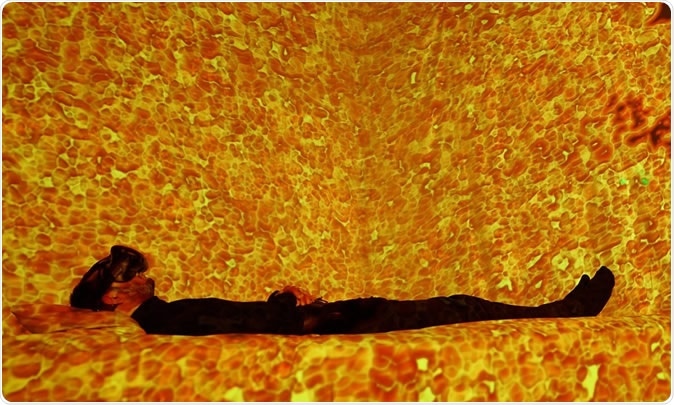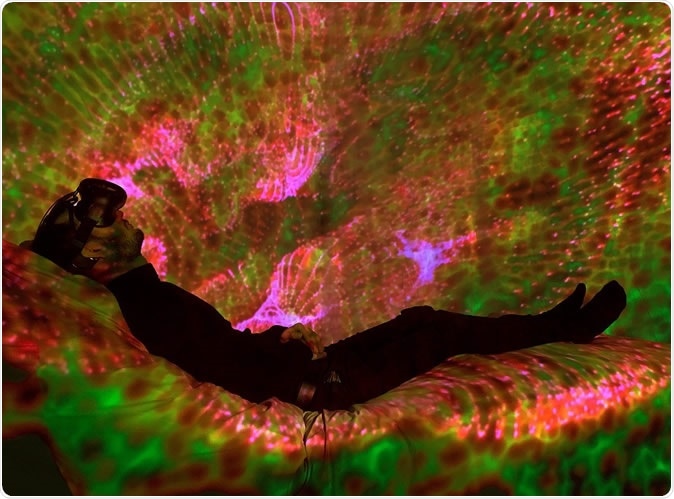Getting good sleep has long been a problem the world over, and its importance in contributing to many illnesses, both mental and bodily, has been acknowledged.
Now a team of researchers has designed an interactive virtual reality bed called InterDream to promote the changes that facilitate sleep. The system includes customized music and visuals that are controlled by the user’s brainwaves.

The Inter-Dream system. Participants manipulate graphical imagery through EEG, which projected around the room and in VR while resting in an interactive bed.
Technology is typically shown to disrupt sleep, delaying its onset and shortening its duration. However, the new study evaluates an innovative multisensory bed technology designed by PluginHUMAN at the RMIT University’s Exertion Games Lab. The researchers looked at its contribution to inducing a beneficial pre-sleep state, as well as to the general mental health of the user. They assessed physiological and psychological changes, as well as data gathered by interviewing users. The findings were presented at the CHI 2019 conference.

Inter-Dream involves ambient music controlled by the artists, and kaleidoscopic visuals controlled by the user with their own brainwaves, via EEG.
Good sleep depends on bodily state, as well as a specific array of mental and emotional states. These represent changes that should occur before sleep sets in, and are together called pre-sleep. They include winding down, as well as relaxed and happy emotions. Worry and unpleasant thoughts are more likely to occur in people who unwillingly dwell on the events and stressors of the day, and these tend to reduce sleep quality.
Using technological media at sleep times reduces the chances of good sleep. One way to limit this is to avoid exposure to blue light emitting technologies. However, many people find it difficult to sleep without using any technological media at all, which could hinder pre-sleep changes. On the other hand, prior research shows that facilitating creative expression positively affects the mood and emotions, which could promote pre-sleep.
Neurofeedback is a form of biofeedback, where the user is consciously linked to neural processes using bioimaging or similar technology. This can be achieved using non-invasive scalp electrodes to measure and project electrical activity in the brain, called an electroencephalogram (EEG). This technology could allow brain activity to be visualized by the users as it changes in accordance with their thoughts.
InterDream uses neurofeedback, by generating ever-changing abstract visuals in response to the user’s brainwaves. Each type of brainwave is represented as a different color on the image, while the intensity of the brainwave correlates with the movement of the image. Thus each person produces a different kind of image. The interactive nature of the system encourages users to mindfully recognize and change their thinking, as they ‘see’ their success in the changing visual representations. The abstract nature of these images tends to make it easier for the participants to experience mindfulness and playful exploration of their mind-brain connections and thinking.
CHI 2019: Towards Understanding the Design of Positive Pre-sleep
In the current study, researchers found that these features helped users achieve physiological and psychological pre-sleep changes. They were more relaxed physically, and experienced mental calming and more positivity. Fearfulness was lowered by 55% while overall emotional negativity dropped by 21%. In other words, compared to a passive experience such as listening to music or watching television at bedtime, InterDream actually helps people create their own bedtime journey. This is one reason for the positive effects it produces on people’s feelings. It also encourages mindfulness, drawing away the user’s thoughts from the past or the future to dwell on the present experience.
This was confirmed by objective testing. Researcher Natahan Semertzidis says, “Creative expression is strongly associated with positive effects on emotion and affect. It makes sense that influencing these cognitive mood states can help us better ease into rest. EEG readings were also indicative of restorative restfulness and a clear mind, while interview responses described experiences of mindfulness.”
Co-author Fabio Zembetta pointed out that the utility of the study lies in the finding that neurofeedback technology may be extremely helpful in inducing sleep onset.
Supervisor Professor Mueller also commended the complementary role played by art and science in this innovative method of treating an age-old problem. Rather than treating the human body as a mechanical device, he said, the InterDream system “really puts the human body center stage, allowing people to experience their bodies as play.” He says he looks forward to “a more playful future, where we can experience sleep as a form of play.”
Semertzidis comments: “Technology and sleep are always talked about as incompatible. Our findings flip that notion upside down and show how technology can also aid rest and relaxation.”
Source:
Journal reference: